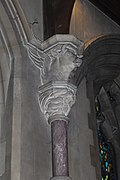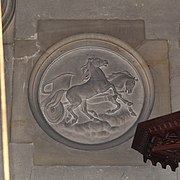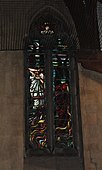
Cathedrals, collegiate churches, and monastic churches like those of abbeys and priories, often have certain complex structural forms that are found less often in parish churches. They also tend to display a higher level of contemporary architectural style and the work of accomplished craftsmen, and occupy a status both ecclesiastical and social that an ordinary parish church rarely has. Such churches are generally among the finest buildings locally and a source of regional pride. Many are among the world's most renowned works of architecture. These include St Peter's Basilica, Notre-Dame de Paris, Cologne Cathedral, Salisbury Cathedral, Antwerp Cathedral, Prague Cathedral, Lincoln Cathedral, the Basilica of Saint-Denis, Santa Maria Maggiore, the Basilica of San Vitale, St Mark's Basilica, Westminster Abbey, Saint Basil's Cathedral, Antoni Gaudí's incomplete Sagrada Família and the ancient cathedral of Hagia Sophia in Istanbul, now a mosque.

The Cathedral Church of Saint Andrew, also commonly known as St. Andrew's Cathedral, is a cathedral of the Episcopal Church in the United States located in the State of Hawaii. Originally the seat of the Anglican Church of Hawaii, it is now the home of the bishop of the Episcopal Diocese of Hawaii. It is affiliated with St. Andrew's Schools, which consists of the main girls' K-12 school, the coeducational Queen Emma Preschool and a boys' preparatory school (elementary).

The Sacred Heart Cathedral is a Catholic church in Sarajevo; commonly referred as the Sarajevo Cathedral, it is the largest cathedral in Bosnia and Herzegovina. It is the seat of the Archbishop of Vrhbosna, currently Tomo Vukšić, and center of Catholic worship in the city. The cathedral is located in the city's Old Town district.
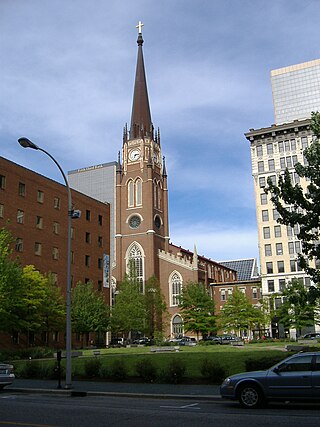
The Cathedral of the Assumption is a Catholic cathedral in Louisville, Kentucky, and the mother church of the Archdiocese of Louisville. It is the seat of Archbishop Shelton J. Fabre, and Martin A. Linebach, vicar general for the archdiocese, serves as rector.

The Agapemonites or Community of The Son of Man was a Christian religious group or sect that existed in England from 1846 to 1956. It was named from the Greek: agapemone meaning "abode of love". The Agapemone community was founded by the Reverend Henry Prince in Spaxton, Somerset. The sect also built a church in Upper Clapton, London, and briefly had bases in Stoke-by-Clare in Suffolk, Brighton and Weymouth.

All Saints Church is an Australian Anglican Church in the Canberra suburb of Ainslie. The church is in the Anglican Diocese of Canberra and Goulburn. The parish holds to a liberal Anglo-Catholic style of churchmanship and theology.
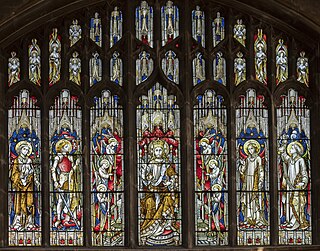
Hardman & Co., otherwise John Hardman Trading Co., Ltd., founded 1838, began manufacturing stained glass in 1844 and became one of the world's leading manufacturers of stained glass and ecclesiastical fittings. The business closed in 2008.

St George's Cathedral is an Antiochian Orthodox church in Albany Street, St Pancras, in the London Borough of Camden. Built to the designs of James Pennethorne, it was consecrated as an Anglican place of worship called Christ Church in 1837. It became an Orthodox cathedral in 1989.
Australian non-residential architectural styles are a set of Australian architectural styles that apply to buildings used for purposes other than residence and have been around only since the first colonial government buildings of early European settlement of Australia in 1788.

Thomas Willement was an English stained glass artist, called "the father of Victorian stained glass", active from 1811 to 1865.

The Cathedral Basilica of Christ the King is a Roman Catholic church in Hamilton, Ontario, Canada. The cathedral was consecrated on December 19, 1933. It is the seat of the bishop of the Diocese of Hamilton, and the cathedral of the Diocese of Hamilton. The cathedral contains the cathedra of the bishop, the Most Rev. Douglas Crosby. The cathedral was raised to the status of a minor basilica in February 2013 by Pope Benedict XVI.
Nicholas Patrick Reyntiens OBE was a British stained-glass artist, described as "the leading practitioner of stained glass in this country."

The Church of St Mary at Charlynch in the parish of Spaxton, Somerset, England was an Anglican Parish Church, but has now been deconsecrated. It dates from the 11th century with a tower probably of 1867. It has been designated as a Grade I listed building.
Joseph Morris was a British architect.

The Hospital of St John Baptist without the Barrs is a building with an adjacent chapel in the city of Lichfield, Staffordshire, England. It is a Grade I listed building.
Cox & Barnard Ltd was a stained glass designer and manufacturer based in Hove, part of the English city of Brighton and Hove. The company was founded in Hove in 1919 and specialised in stained glass for churches and decorative glass products. Many commissions came from Anglican and Roman Catholic churches in the English counties of East Sussex, West Sussex and Kent. The company was also responsible for six war memorial windows at an Anglican church in Canada, made from shards of glass collected from war-damaged church windows across Europe.

The Cathedral of Saint Patrick and Saint Felim, also known as Cavan Cathedral, is a Roman Catholic cathedral located in Cavan, Ireland. It is the seat of the Bishop of Kilmore, and the mother church of the Roman Catholic Diocese of Kilmore.

St Josephs Cathedral is a heritage-listed Roman Catholic cathedral at 170 William Street, Allenstown, Rockhampton, Rockhampton Region, Queensland, Australia. It was designed by Francis Drummond Greville Stanley and built from 1893 to 1982. It was added to the Queensland Heritage Register on 21 October 1992. The cathedral serves as the seat for the Bishop of Rockhampton.

Nicola D'Ascenzo was an Italian-born American stained glass designer, painter and instructor. He is best known for creating stained glass windows for the Washington Memorial Chapel in Valley Forge, Pennsylvania; the Nipper Building in Camden, New Jersey; the Loyola Alumni Chapel of Our Lady at Loyola University Maryland; the Folger Shakespeare Library and Washington National Cathedral, both in Washington, D.C.
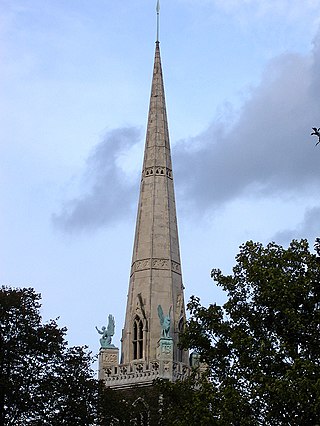
Clapton is a district of East London, England, in the London Borough of Hackney.




